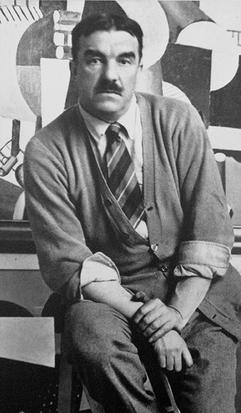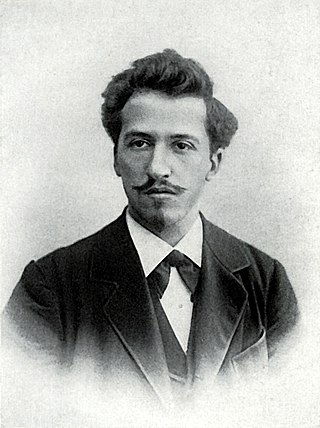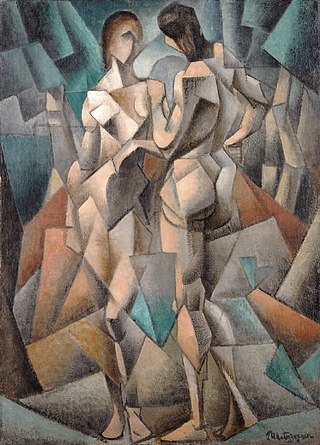
Georges Braque was a major 20th-century French painter, collagist, draughtsman, printmaker and sculptor. His most notable contributions were in his alliance with Fauvism from 1905, and the role he played in the development of Cubism. Braque's work between 1908 and 1912 is closely associated with that of his colleague Pablo Picasso. Their respective Cubist works were indistinguishable for many years, yet the quiet nature of Braque was partially eclipsed by the fame and notoriety of Picasso.

Cubism is an early-20th-century avant-garde art movement that revolutionized European painting and sculpture, and inspired related artistic movements in music, literature, and architecture. In Cubist works of art, the subjects are analyzed, broken up, and reassembled in an abstract form—instead of depicting objects from a single perspective, the artist depicts the subject from multiple perspectives to represent the subject in a greater context. Cubism has been considered the most influential art movement of the 20th century. The term cubism is broadly associated with a variety of artworks produced in Paris or near Paris (Puteaux) during the 1910s and throughout the 1920s.

New materials in 20th-century art were introduced to art making from the very beginning of the century. The introduction of new materials and heretofore non-art materials helped drive change in art during the 20th century. Traditional materials and techniques were not necessarily displaced in the 20th century. Rather, they functioned alongside innovations that came with the 20th century. Such mainstays as oil-on-canvas painting, and sculpting in traditional materials continued right through the 20th century into the 21st century. Furthermore, even "traditional" materials were greatly expanded in the course of the 20th century. The number of pigments available to artists has increased both in quantity and quality, by most reckoning. New formulations for traditional materials especially the commercial availability of acrylic paint have become widely used, introducing initial issues over their stability and longevity.

Marc Chagall was a Russian-French artist. An early modernist, he was associated with several major artistic styles and created works in a wide range of artistic formats, including painting, drawings, book illustrations, stained glass, stage sets, ceramics, tapestries and fine art prints.

Joseph Fernand Henri Léger was a French painter, sculptor, and filmmaker. In his early works he created a personal form of cubism which he gradually modified into a more figurative, populist style. His boldly simplified treatment of modern subject matter has caused him to be regarded as a forerunner of pop art.
The White Crucifixion is a painting by Marc Chagall depicting the Crucifixion of Jesus. It was painted in 1938 after Chagall had visited Europe, and is in the permanent collection of the Art Institute of Chicago.

Pieter Cornelis Mondriaan, after 1906 known as Piet Mondrian, was a Dutch painter and art theoretician who is regarded as one of the greatest artists of the 20th century. He is known for being one of the pioneers of 20th-century abstract art, as he changed his artistic direction from figurative painting to an increasingly abstract style, until he reached a point where his artistic vocabulary was reduced to simple geometric elements.

Proto-Cubism is an intermediary transition phase in the history of art chronologically extending from 1906 to 1910. Evidence suggests that the production of proto-Cubist paintings resulted from a wide-ranging series of experiments, circumstances, influences and conditions, rather than from one isolated static event, trajectory, artist or discourse. With its roots stemming from at least the late 19th century, this period is characterized by a move towards the radical geometrization of form and a reduction or limitation of the color palette. It is essentially the first experimental and exploratory phase of an art movement that would become altogether more extreme, known from the spring of 1911 as Cubism.

Académie de La Palette, also called Académie La Palette and La Palette,, was a private art school in Paris, France, active between 1888 and 1925, aimed at promoting 'conciliation entre la liberté et le respect de la tradition'.

Portrait of Jacques Nayral is a large oil painting created in 1911 by the French artist, theorist and writer Albert Gleizes (1881–1953). It was exhibited in Paris at the Salon d'Automne of 1911, the Salon de la Section d'Or, 1912, and reproduced in Du "Cubisme" written by Jean Metzinger and Albert Gleizes in 1912, the first and only manifesto on Cubism. Metzinger in 1911 described Gleizes' painting as 'a great portrait'. Portrait of Jacques Nayral, one of Gleizes' first major Cubist works, while still 'readable' in the figurative or representational sense, exemplifies the mobile, dynamic fragmentation of form characteristic of Cubism at the outset of 1911. Highly sophisticated in theory and in practice, this aspect of simultaneity would soon become identified with the practices of the Section d'Or. Here, Gleizes deploys these techniques in a radical, personal and coherent manner.

Man on a Balcony, is a large oil painting created in 1912 by the French artist, theorist and writer Albert Gleizes (1881–1953). The painting was exhibited in Paris at the Salon d'Automne of 1912. The Cubist contribution to the salon created a controversy in the French Parliament about the use of public funds to provide the venue for such 'barbaric art'. Gleizes was a founder of Cubism, and demonstrates the principles of the movement in this monumental painting with its projecting planes and fragmented lines. The large size of the painting reflects Gleizes's ambition to show it in the large annual salon exhibitions in Paris, where he was able with others of his entourage to bring Cubism to wider audiences.

Man with a Pipe, also referred to as Portrait of an American Smoker, Portrait of an American Smoking, American Smoking and American Man, is a painting by the French Cubist artist Jean Metzinger. The work was reproduced on the cover of catalogue of the Exhibition of Cubist and Futurist Pictures, Boggs & Buhl Department Store, Pittsburgh, forming part of a show in 1913 that traveled to several U.S. cities: Milwaukee, Cleveland, Pittsburgh, New York, and Philadelphia.

L'Arbre , is a painting created in 1910 by the French artist, theorist and writer Albert Gleizes. Executed in an advanced Proto-Cubist style, the work was exhibited in Paris at the Salon des Indépendants, 1910, the following year Gleizes chose to exhibit this work at the Salon de la Section d'Or, Galerie La Boétie, 1912, and Manes Moderni Umeni, S.V.U., Vystava, Prague, 1914. The painting was again shown at the Grand Palais, Salon des Indépendants, Trente ans d'art indépendant, in 1926. L'Arbre, an important work of 1910, appeared at the decisive Salon des Indépendants of 1911, where Cubism emerged as a group manifestation and spread across the globe, at times shocking the general public.

Passy, Bridges of Paris, also called Les ponts de Paris (Passy), or Paysage à Passy, is a painting created in 1912 by the French artist, theorist and writer Albert Gleizes. The work was exhibited at the Salon de la Société Normande de Peinture Moderne, Rouen, 1912 (titled Passy); the Salon de la Section d'Or, Galerie La Boétie, Paris, 1912 (titled Passy); Manes Moderni Umeni, Vystava, Prague, 1914 (titled Paysage à Passy); and Galerie Der Sturm, Berlin, July, 1914.

Groupe de femmes, also called Groupe de trois femmes, or Groupe de trois personnages, is an early Cubist sculpture created circa 1911 by the Hungarian avant-garde, sculptor, and graphic artist Joseph Csaky (1888–1971). This sculpture formerly known from a black and white photograph had been erroneously entitled Deux Femmes , as the image captured on an angle showed only two figures. An additional photograph found in the Csaky family archives shows a frontal view of the work, revealing three figures rather than two. Csaky's sculpture was exhibited at the 1912 Salon d'Automne, and the 1913 Salon des Indépendants, Paris. A photograph taken of Salle XI in sitiu at the 1912 Salon d'Automne and published in L'Illustration, 12 October 1912, p. 47, shows Groupe de femmes exhibited alongside the works of Jean Metzinger, František Kupka, Francis Picabia, Amedeo Modigliani and Henri Le Fauconnier.

Deux Nus is an early Cubist painting by the French artist and theorist Jean Metzinger. The work was exhibited at the first Cubist manifestation, in Room 41 of the 1911 Salon des Indépendants, Paris. At this exhibition the Cubist movement was effectively launched before the general public by five artists: Metzinger, Gleizes, Le Fauconnier, Delaunay and Léger. This was the first exhibition during which artists, writers, critics and the public at large encountered and spoke about Cubism. The result of the group show is a succès de scandale.

Les Peintres Cubistes, Méditations Esthétiques, is a book written by Guillaume Apollinaire between 1905 and 1912, published in 1913. This was the third major text on Cubism; following Du "Cubisme" by Albert Gleizes and Jean Metzinger (1912); and André Salmon, Histoire anecdotique du cubisme (1912).

Crystal Cubism is a distilled form of Cubism consistent with a shift, between 1915 and 1916, towards a strong emphasis on flat surface activity and large overlapping geometric planes. The primacy of the underlying geometric structure, rooted in the abstract, controls practically all of the elements of the artwork.

Cubist Landscape, also referred to as Tree and River and Paysage cubiste or Arbre et fleuve, is a Cubist painting created in 1914 by the French artist, theorist and writer Albert Gleizes. Tree and River is one of Gleizes' last pre-World War I landscapes. A comparison with earlier works such as Le Chemin, Paysage à Meudon (1911), Les Baigneuses (Gleizes) (1912), Harvest Threshing (1912) and Passy, Bridges of Paris (1912) demonstrates the artists' continuity with the theme of deep spatial vistas and wide panoramic views, though with a notable diminution of specific references to reality. The painting was reproduced in the German art and literary magazine Der Sturm October 1920.

Bords de la Marne, also called Les Bords de la Marne and The Banks of the Marne, is a proto-Cubist oil painting on canvas created in 1909 by the French artist, theorist and writer Albert Gleizes. In this work can be seen a departure from the representation of the observable world. The development of Cubist and abstract art in the work of Gleizes was necessarily a transformation from the synthetic preoccupation with his subject matter. The passage of Gleizes' painting from an epic visionary figuration to total abstraction was foreshadowed during his proto-Cubist period. Bords de la Marne measures 54 × 65 cm, and is currently in the permanent collection of the Musée des Beaux-Arts de Lyon.



















